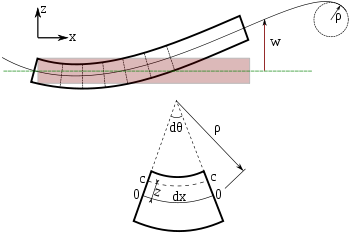Euler–Bernoulli beam theory

Euler–Bernoulli beam theory (also known as engineer's beam theory or classical beam theory)[1] is a simple method to calculate bending of beams when a load is applied. This applies to small deflections (how far something moves) of a beam without considering effects of shear deformations. Therefore, it can be considered a special case of the Timoshenko beam theory. It was first introduced around 1750.[2] It gained popularity during the development of the Eiffel Tower and the Ferris wheel in the late 19th century. After that, it was used in many engineering fields including mechanical engineering and civil engineering. Although other advanced methods have been developed, the Euler-Bernoulli beam theory is still widely used because of its simplicity.
History
[change | change source]
Leonhard Euler and Daniel Bernoulli were the first to put together the theory in 1750.[3] At the time, science and engineering were viewed differently than today. Mathematical theories such as the Euler-Bernoulli Beam theory were not trusted for practical engineering use. Bridges and buildings continued to be designed using the same methods until the late 19th century. This is when the Eiffel Tower and Ferris wheel showed the validity of the theory on a larger scale.
Static beam equation
[change | change source]
The Euler–Bernoulli equation describes the relationship between the beam's deflection and the applied load is as shown below:[4]
Where describes the deflection of the beam in the direction at some position . is a distributed load, in other words a force per unit length (analogous to pressure being a force per area); it may be a function of , , or other variables.
References
[change | change source]- ↑ Timoshenko, S., (1953), History of strength of materials, McGraw-Hill New York
- ↑ Truesdell, C., (1960), The rational mechanics of flexible or elastic bodies 1638-1788, Venditioni Exponunt Orell Fussli Turici.
- ↑ Seon M. Han, Haym Benaroya and Timothy Wei (March 22, 1999). "Dynamics of Transversely Vibrating Beams using four Engineering Theories" (PDF). Journal of Sound Vibration. final version. 225 (5). Academic Press: 935. Bibcode:1999JSV...225..935H. doi:10.1006/jsvi.1999.2257. Archived from the original (PDF) on 2011-07-20. Retrieved 2007-04-15.
- ↑ Gere, J. M. and Timoshenko, S. P., 1997, Mechanics of Materials, PWS Publishing Company.






